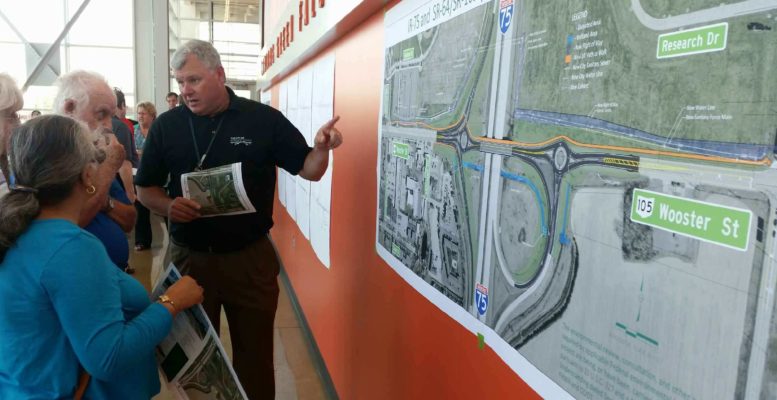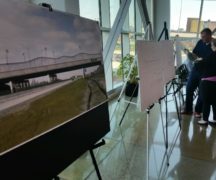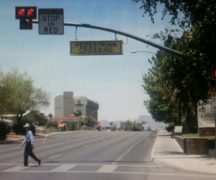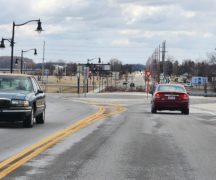By JAN LARSON McLAUGHLIN
BG Independent News
Citizens got to heap compliments and complaints earlier this week on Bowling Green’s plans to recreate its image from the interstate.
Giant drawings showed plans for roundabouts at I-75 and East Wooster Street, a walk- and bike-path along Wooster, and a new decorative look to the bridge over the interstate.
“It’s beautiful. I think it’s going to organize traffic in and out of the city,” and prevent accidents in the process, said Brandon Welsh, operations manager at Best Western on East Wooster Street.
The project will add two roundabouts designed for semi-trucks at both Interstate 75 interchanges on East Wooster Street. The bridge driving surface will be replaced, with a bike-pedestrian trail being added from Alumni Drive to Dunbridge Road along north side of Wooster Street. The plan calls for a landscaped gateway to be created to Bowling Green and Bowling Green State University.
Though utility work will begin in 2018, the bulk of the actual interchange and roadway work will take place in 2019.
”I’m very excited about the new pedestrian improvements,” said Chris Frey, who lives close to downtown but said he would use the bikeway along East Wooster to the Meijer store. “I’m looking forward to it. I’d be very happy to ride my bicycle to the store.”
The more accommodations the city can make for bicyclists and pedestrians, the better, Frey said. “We don’t have a culture of stopping for pedestrians.” But that may come, he added.
Dawn McCaghy also liked the addition of 10-foot wide bike and pedestrian lane over I-75 that will be made possible by one of the westbound vehicle lanes being eliminated.
“I like the pedestrian and bicycle pathway,” she said. “We see students walking on the roadway all the time.”
As far as the roundabouts, McCaghy admitted a little apprehension. “I guess I’m sort of neutral, but I know I’ll have some trouble at first.”
Her husband, Charles McCaghy, noted that roundabouts work successful in so many other places.
“Once people get used to them, they’ll say, ‘How did we every get on without them?’” he said. “We’re not exactly breaking ground.”
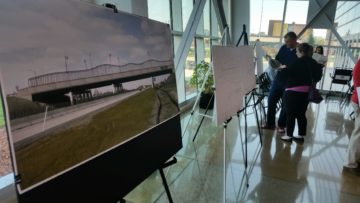
Drawing of new bridge over Interstate 75
One woman expressed concern that the roundabouts will be difficult to navigate, and asked if they will be smallish like the rotary in front of Terra Tech in Fremont.
Bowling Green Public Works Director Brian Craft said that the roundabout in front of Terra Tech is “too small,” and the Bowling Green ones will be much larger. “They are designed for truck traffic,” he said.
Dale Calcamuggio, transportation administrator with the Ohio Department of Transportation, said he expects motorists to quickly adapt to the roundabouts.
“I think so, absolutely,” he said. He mentioned the roundabout near Anthony Wayne, at the corner of Ohio 64 and Fintel. “It took a bit of time, but people get used to it.”
The plans also call for the eastbound and westbound lanes on Wooster Street to be divided, with traffic needed to use the roundabouts to change directions to enter or exit businesses. Welsh expressed some concerns that the change may inconvenience drivers.
But Calcamuggio said it will be safer than trying to cross multiple lanes of traffic. “That’s quite a bit safer than trying to get through all that traffic. Sometimes you can sit down there 15 minutes to get out,” he said about motorists trying to exit businesses to head west.
Though not part of this project, the city is also applying for funding assistance for two more roundabouts on East Wooster – at Dunbridge and Campbell Hill roads.
Peg Bucksky, who works at BGSU and lives in Stadium View Apartments, had lots of questions since the project will be in her front yard. Her biggest concern was whether or not she will be able to access I-75 during the construction. The answer was yes – all except about one week toward the end of the project.
Overall, Bucksky liked what she saw during the open house.
“I love how this is going to look,” she said, pointing to the decorative bridge drawings. The project will give the city entrance an completely new image, she asid.
Bucksky still had some reservations about how the roundabouts will work. “I’m interested to see how it works for Bowling Green. It’s hard to imagine how it keeps people moving.”
Following is more information on the project:
Costs
- Current overall construction cost is $8.9 million, not including engineering, inspection or right-of-way.
- ODOT share is approximately $750,000 of safety funds and $1.5 million for bridge rehabilitation (possibly more for shared items.)
- 16-inch waterline relocation, $800,000.
- Sanitary sewer replacement and pump station, $1.4 million.
- City share approximately $6.7 million (includes city roadway costs and utilities). A bond is planned to be issued to finance the project.
- Wood County Commissioners have committed $300,000 to help with project.
Construction schedule
- Anticipate construction beginning around September 2018.
- Only construction in 2018 and early 2019 would be waterline and sanitary sewer/pump station
- Phase 1 bridge work could begin March 2019
- Roadway work starting March/April 2019
- Completion around October/November 2019
Aesthetics
- Stone pavers at the inside of the roundabout and at larger splitter islands.
- River rock in center islands and splitter islands.
- Plantings in roundabout center islands.
- Decorative lighting.
- Decorative fencing and lighting on bridge.

